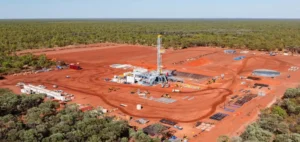Woodside Energy Group Ltd reports a portfolio in sustained execution, combining progress on cornerstone projects, cost optimization and cash-flow generation. Production totals 99.2 MMboe, or 548 Mboe/d, with an average unit cost of $7.7/boe. Net profit after tax (NPAT – net profit after tax) is $1,316 million, and the board sets an interim dividend of 53 cents per share (cps – cents per share). The focus remains strictly industrial and financial, supported by the operational reliability of liquefied natural gas (LNG – liquefied natural gas) and oil assets.
Financial performance, liquidity and discipline
Revenue amounts to $6,590 million and underlying EBITDA (earnings before interest, taxes, depreciation and amortization – résultat opérationnel brut) reaches $4,600 million, reflecting the contribution from producing assets and Sangomar’s ramp-up. Net operating cash flow totals $3,339 million, while the gearing ratio stands at 19.5% within the target range. The company raises $3,500 million via multi-tranche unsecured US bonds and refinances $1,200 million of syndicated facilities, reinforcing liquidity of $8,430 million. Free cash flow is $272 million after investments and recognition of proceeds from the partial divestment of Louisiana LNG Infrastructure LLC.
Marketing and trading generate EBIT of $144 million, about ~8% of total EBIT, driven by optimization of own and third-party volumes. Hedges are in place on around 30 MMboe for 2025 at an average price of $78.7/bbl, and on Corpus Christi volumes via Henry Hub and Title Transfer Facility (TTF – Title Transfer Facility) swaps, with a coverage rate of ~94% for the remainder of 2025 and 87% for 2026. On long-term contracts, Woodside signs two sales and purchase agreements (SPAs – sales and purchase agreements) with Uniper for up to 2.0 Mtpa linked to Louisiana LNG and to its portfolio, as well as an SPA with China Resources Gas (~0.6 Mtpa over 15 years from 2027), and memoranda of understanding with JERA Co. and PETRONAS.
Major projects and industrial milestones
On Scarborough (a new LNG chain connected to Pluto LNG), overall progress reaches 86%, with hull-topsides integration of the floating production unit (FPU) completed and subsea activities ready for arrival. First LNG cargo is targeted for the second half of 2026, while Pluto Train 2 continues piping, cabling and electrical testing. Trion (Gulf of Mexico) is 35% complete, with first oil targeted in 2028 and all subsea equipment and control systems ordered. Beaumont New Ammonia (1.1 Mtpa capacity) is 95% complete, with first ammonia production planned for late 2025 and a ramp-up in “lower-carbon ammonia” from 2026, subject to commissioning of the carbon capture and storage (CCS – carbon capture and storage) chain.
The final investment decision (FID – final investment decision) for Louisiana LNG covers a first phase with three trains (16.5 Mtpa), with notice to proceed issued to Bechtel and Train 1 at 22% execution. Woodside sells 40% of Louisiana LNG Infrastructure LLC to Stonepeak, which will contribute 75% of the capex expected in 2025–2026 (a total of $5.7 billion), while Woodside retains control and continues sell-down discussions. A supply agreement for up to 640 Gcf of gas is concluded with bp starting in 2029, and the company secures transportation capacity via construction of the “Line 200” lateral.
In Senegal, Sangomar operates at ~100 kb/d (Woodside share 80 kb/d), with 98.6% reliability, 36 cargoes delivered and additions to proved and probable reserves following performance of the S400/S500 reservoirs. In Australia, North West Shelf permanently retires Train 2 of the Karratha Gas Plant, reducing nameplate capacity from 16.9 to 14.3 Mtpa, while in the Bass Strait Woodside agrees to assume operatorship (completion subject to conditions) with potential wells identified to secure domestic supply. Decommissioning expenditure totals ~$565 million for the half and a restoration charge of $445 million is recognized, reflecting updated plans for Minerva, Stybarrow and Griffin. These items remain integrated within a cost and reliability trajectory aimed at stability of cash flows and industrial visibility.






















